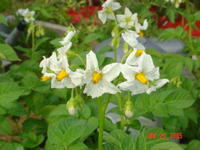There are over 600 varieties of garlic in the world. But to make it simpler, and to paraphrase Julius Caesar:
Allium Sativuum est omnis divisa in partes duo, quarum unam incolunt Ophioscorodan.The Ophios are the most fun, I think. Their partner, the soft-necked sativuums, have their own charms, but I prefer the mysteries of the stiff necked Ophios.
The Ophios (capitalization my preference) are closer to the wild. They send up a scape in late June or early July which if left alone would flower and send out seeds. I choose to cut off my scapes and use them in stir-frys and for grilling. There is nothing quite like harpooned swordfish infused with garlic scapes on the grill.
Not all growers cut off their scapes. They let them uncurl and flower and then they cure them with the woody scapes intact. The thought is that it helps to harden off the garlic and helps it to store longer. Most Ophios go bad by Christmas.
The scape will steal from the size of your bulb, and at the Ag Fair “size matters.” After many years of red ribbons, I finally won the coveted blue ribbon at last year’s fair. As I survey my garlic beds, I can already tell by the girth of the collective leaf sheath which my contenders might be. They are all Spanish Rojas. The German Browns were supposed to be even larger, but so far I am not impressed by their performance.
Ophios are divided into sub-classes. The Rocambole is my favorite. While the garlic itself doesn’t last very long, the scapes put on quite a show curling around on themselves almost three times. The other two subclasses are Porcelains and Purple Stripes.
Here’s what I have in the ground this year.
Stiff-neckedRocamboles
- Spanish Roja, Killarney Red, German Brown
Purple Striped
- Chesnok Red, Persian Star
Porcelain
- Music Pink, Romanian Red
Soft NeckedSilverskin
- Nootka Rose
Artichoke
- Inchellium Red, Susanville, Lukak, Oregon Blue, Chet's Italian Red
This is my eighth season of planting garlic (is that possible?) I have relied on Filaree Farm in Okanogan, Washington as my supplier of new seed garlic, though I have built my own “sire stock” over the years. I have relied heavily on the book they publish called Growing Great Garlic. By far the best performer for my climate is Spanish Roja.
Well, there will be more to report about garlic later during the Great S-Scape season.


